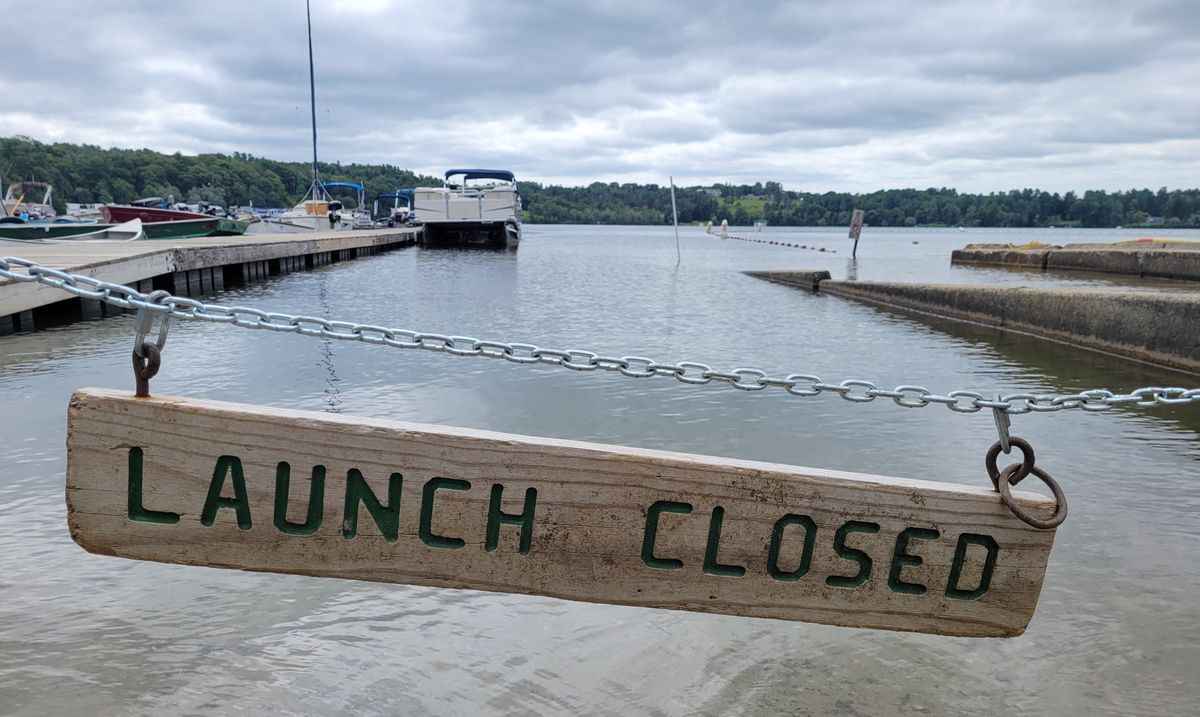
The boat launch at Lakeville Lake is closed indefinitely due to the hydrilla threat.
Debra A. Aleksinas

The boat launch at Lakeville Lake is closed indefinitely due to the hydrilla threat.
This is the first of a series on invasive aquatic hydrilla and its growing threat to waterbodies and communities in Northwest Connecticut.
SALISBURY — It was only a matter of time.
Since 2016, an aggressive non-native aquatic plant, Hydrilla verticillata, also known as water thyme, has fouled coves and tributaries along the Connecticut River from Essex to the Massachusetts border, leaving unprecedented ecological, recreational and economic damage in its wake.
Now it has hitched a ride via unsuspecting boat owners to inland freshwater lakes and ponds around the state, causing concern among lake associations, town and state officials.
To date, the submerged perennial plant, fittingly named after Hydra, the nine-headed serpent from Greek mythology known for its regenerative powers, has been identified in at least 10 known lakes and ponds in the state.
That number is expected to rise as scientists from the Connecticut Aquatic Experiment Station’s Office of Aquatic Species (CAES/OAIS) scour 94 state-owed marinas in search of the worrisome weed, which they fear is spreading undetected.
Time is of the essence to locate, control and eradicate an aggressive subspecies of Hydrilla verticillata, which is unique to the Connecticut River and grows at an astonishing rate of up to a foot a day with long, slender stems that can grow underwater to lengths of up to 30 feet and spread horizontally into thick mats.
Fragments that contain as little as a single whorl of leaves are capable of drifting to other parts of a waterbody and forming new colonies. Left unchecked, perennial hydrilla, which has earned the title of “the world’s worst invasive aquatic plant” and is listed as a federal noxious weed, can completely displace native submerged plant communities, altering fish populations and water chemistry, and threatening bald eagles.
Last summer, East Twin Lake in Salisbury raised alarm when it became the first documented lake outside of the Connecticut River to become infested with a Connecticut River variant of hydrilla. Lake officials suspect it had been thriving undetected beneath the lake’s surface around the marina for several years before being noticed during a routine lake survey. [See timeline here].
Ripples of invasion
Hydrilla, native to Africa and Southeast Asia, has had a rich introduction history into the United States, with multiple subspecies being introduced since the 1960’s. It was first introduced to this country in the early 1950s near Tampa, Fla., when an aquarium plant dealer dumped bundles of the lush, green plant into a canal near his business, and by the early 1990s hydrilla occupied more than 140,000 acres of public lakes and rivers.
In 2016 a new variant of Hydrilla verticillata, subspecies lithuanica, also known as Northern hydrilla, was identified in the Connecticut River, and three years later the CAES surveyed the river from Agawam, Mass., to the Long Island Sound, reporting at least 774 acres of hydrilla.
“The particular strain that is unique to the Connecticut River appears to be much more aggressive and robust than anything we have seen before,” said Gregory Bugbee, who runs the Invasive Plant Program at the Connecticut Agricultural Experiment Station (CAES)
And it is difficult and expensive to manage and eradicate.
“Significant costs are already associated with the impact and maintenance of the prior two subspecies established in the United States since the 1960s and 1980’s,” according to Jeremiah Foley, assistant scientist with CAES.
Why hydrilla management is important
The alarming explosion of Connecticut River hydrilla outside of the Connecticut River has raised significant concerns about its spread inland, threatening the beauty and pristine nature of many of its waterbodies.
The worrisome weed can outcompete native species, replacing habitat for sensitive species including migratory fish. Thick, horizontally-growing mats of hydrilla have crowded out boaters, anglers and those who recreate on the Connecticut River.
Marinas and municipalities have reported that they can no longer access boat slips and docks due to hydrilla infestations, limiting business opportunities. Extensive stands of hydrilla can obstruct swimmers and other water-related activities. The plant can also hurt tourism and impact the value of real estate that depends upon attractive waterways.
“The threat of hydrilla gaining a foothold in our lakes here in the Northwest Corner is an increasing concern of the highest levels.”— John Harney, Salisbury real estate agent
"The threat of hydrilla gaining a foothold in our lakes here in the Northwest Corner is an increasing concern of the highest levels,” said John Harney, a real estate broker with Willaim Pitt Sotheby’s International Realty in Salisbury.
“Twin Lakes commands the highest values for real estate, but this all changes if the lake becomes clogged with hydrilla. I would hope that this is a clarion call to bring all of our resources and attention to solving not only the hydrilla issue, but also to address the effects of overdevelopment.”
Since hydrilla’s discovery last summer in East Twin, the nearby boat launch at Lake Wononscopomuc, has been off-limits to outside boaters to keep the lake from becoming infested, and lake officials there intend to keep it closed indefinitely.
“If you lose this wonderful body of water the town would take such a hit. Property values around the lake will drop if you have a lake you can’t boat or swim in, and it’s not just popular for fishing. This is a very recreational lake for the children,” said Stacey Dodge, Town Grove Manager.
Management and control
The best way to manage hydrilla is to prevent its spread in the first place. Boaters are advised to clean, drain and dry their boats, trailers and equipment after leaving a body to keep hydrilla fragments from entering other lakes or rivers.
Once it becomes established, it is a nightmare to control and can cost as much as $1,000 per acre to manage. Many states are spending millions of dollars annually to control it. Lake Associations and towns can face a staggering rise in management costs, even with state and federal assistance.
Research on this very invasive plant is ongoing, as many biological attributes of this subspecies remain unknown, and it has no natural predators or diseases to limit its population. “Because it’s a new strain, it’s been a slow and frustrating process,” noted the Connecticut River Conservancy’s Rhea Drozdenko, River Steward for Connecticut.
Eradication by harvester is discouraged because even the smallest of fragments can spread and repopulate, and the introduction of grass carp into lakes is not a viable option, according to Foley, because while the fish will eat hydrilla, they will also devour every other aquatic plant within the lake. Biological control, he recently told members of the Twin Lakes Association during the group’s annual meeting at Camp Isola Bella on East Twin, is still in its infancy.
Aquatic herbicides have shown the most promise.
Coming next: A visit to the Connecticut River, where researchers are testing various aquatic herbicides at five sites.
Karen Lundeen of Salisbury looks over the poinsettias on sale at the Housatonic Valley Regional High School Holiday Store.
FALLS VILLAGE — Shoppers at the Housatonic Valley FFA Holiday Store are greeted with the sweet smell of pine as they step out of their cars.
“People are looking for nostalgia at Christmas,” said David Moran, department chairman of the agriscience and technology program at the school. “They remember a summer evening on a lake surrounded by pine trees that brings back fond memories or other experiences like that when they come here.”
The scent is derived from the rows of Christmas trees and the carefully created wreaths that line the yard of Housatonic Valley Regional High School’s agricultural wing. Inside, there is a burst of red where poinsettias fill the greenhouse.
The store has been a longstanding tradition at the school. Residents from around the area come back each year to not only purchase their Christmas staples, but support a very popular program. The store is primarily student-run where the teens learn a variety of skills, said Moran. Among those he ticked off are business management, providing service to the community, learning how to produce a quality product and how to interact with adults.
“Most of all they learn how to use their time wisely,” he said. At that point the internet system went down and credit cards could not be used for a period of time. When student Kevin Eisermann figured out what was wrong, Moran added problem solving to the list.
Eisermann, who, along with his sister Kellie Eisermann transferred to Housatonic from Webutuck Central School in Amenia, New York, said he enjoyed the activity. His father owns a business, so he is used to meeting and talking with people.

There are three varieties of trees being sold: balsam, fraser and silver firs, explained Moran. “Firs have three qualities: friendly, fragrant and flat-needled.” This year there was an inventory of 784 trees and 650 wreaths, the latter which are created during two nights when the community comes together to help the students produce them. Poinsettias totaled 500.
Funds raised from the project are put toward attendance at conventions and leadership programs for students. A portion also goes to area food pantries.
Students were bustling around on Saturday, helping patrons choose trees, cut them to size, wrap them and hoist them on vehicles. They took turns manning the cash registers. They appeared to have learned their lessons well, eagerly assisting customers with cheerful demeanors.
Many of the buyers said they come to the sale each year. Several had children go through the program and chatted with Moran, who has been at the school for 30 years, about what career paths they’d followed.
Stephanie Plunkett of Sharon, whose son attended the program, said, “I love this sale. And isn’t the smell good?” Rebecca Trahan said she always buys her tree at the store. “I like to support the students.” Bentley Chou of Salisbury was there with her family. She said this was their first time. “We usually cut down our own, but the offerings this year weren’t as good.” Dean Yuliano of Lakeville also had children who went through the program. “We come every year. They always have good trees.”
Music and merriment filled Salisbury Saturday, Dec. 6 and Sunday, Dec. 7, as the community took part in a weekend of festive activities around town. The Salisbury Stroll down a snowy Main Street, the tree lighting, parade of lights, Holiday Baroque music concert at the Congregational Church and a seasonal market at Noble Horizons spread cheer throughout the town.

Merry carollers braved the evening chill Saturday, Dec. 6, to sing holiday classics like “Jingle Bells” and “Silent Night” on the Town Green.
SHARON — Downtown Sharon was alive with holiday cheer on Saturday afternoon, Dec. 6, for a lineup of family programming that culminated in a tree-lighting ceremony that Hallmark could only dream of.
To start things off, Santa arrived at the Hotchkiss Library at 2 p.m. sharp, bringing in scores of Sharon’s youngsters anxious to know whether they had made the nice list. According to Santa, there wasn’t a thing to worry about: “They’re always nice!” he said, as nine-month old Owen sat in his lap for his first encounter with old Saint Nick.
When not otherwise engaged with the man from up north, children roamed the library, working on crafts or sampling cookies to decide winners in three categories: kid-baked, adult-baked and prettiest. Submissions included “Grinch,” “pinecone” and “great grandmother’s Christmas cookies,” among others.
Light snacks were available for more mature palates, too, with ample charcuterie trays proving a popular selection, alongside sweeter options like toffee and blondies.
As the light faded over the snow-covered village outside, families bravely left the library’s warmth for the Town Green where a festive group was growing in advance of the tree-lighting.
With the orange sky reflecting on the snow, the Salisbury Band Christmas Brass and Hot Chocolate Society started up with some warm tones as members of the Historical Society passed out Christmas carol lyric sheets and electric candles.
After the band led the assembled group in a spirited rendition of “o Christmas Tree,” the broad evergreen was lit with rings of colored bulbs.
Standing before the now-illuminated tree, the Sharon Playhouse’s cast of “Peter Pan,” an upcoming production that will run Dec. 17 to Dec. 21, performed a few preview tunes. “Happy Holidays!” the troupe proclaimed in unison, quite friendly though they were ostensibly pirates at the time. A voice from the crowd, clearly moved, shouted out: “Never grow up!”
As darkness descended on the scene, an all-ages group of more than 100 Sharonites stuck around for an extended caroling session that had passing motorists slowing down as they flanked the Town Green, surely wondering if they’d left 2025 for 1955.
Post-wassail, the Sharon Historical Society invited the jolly crowd to warm up inside its expertly-curated museum, where revelers refreshed themselves on cider and cookies.
Confectionary construction filled the Cornwall Library Sunday, Dec. 7, for the annual gingerbread house competition. West Cornwall’s covered bridge is a popular theme each year, and this year some entries took the inspiration a step further. Lily Landau-Willis and her mother, Jessica, showed a truck stuck in the covered bridge (above). Unfortunately, that has happened several times. Harper and Emerson Stefanski (below) created a damaged version of the bridge, having witnessed some mishaps that occurred on the span. Their mother, Heidi Stefanski, acknowledged she forgot to make one wall, so the damaged look fit. Each submission to the contest received a unique award.
